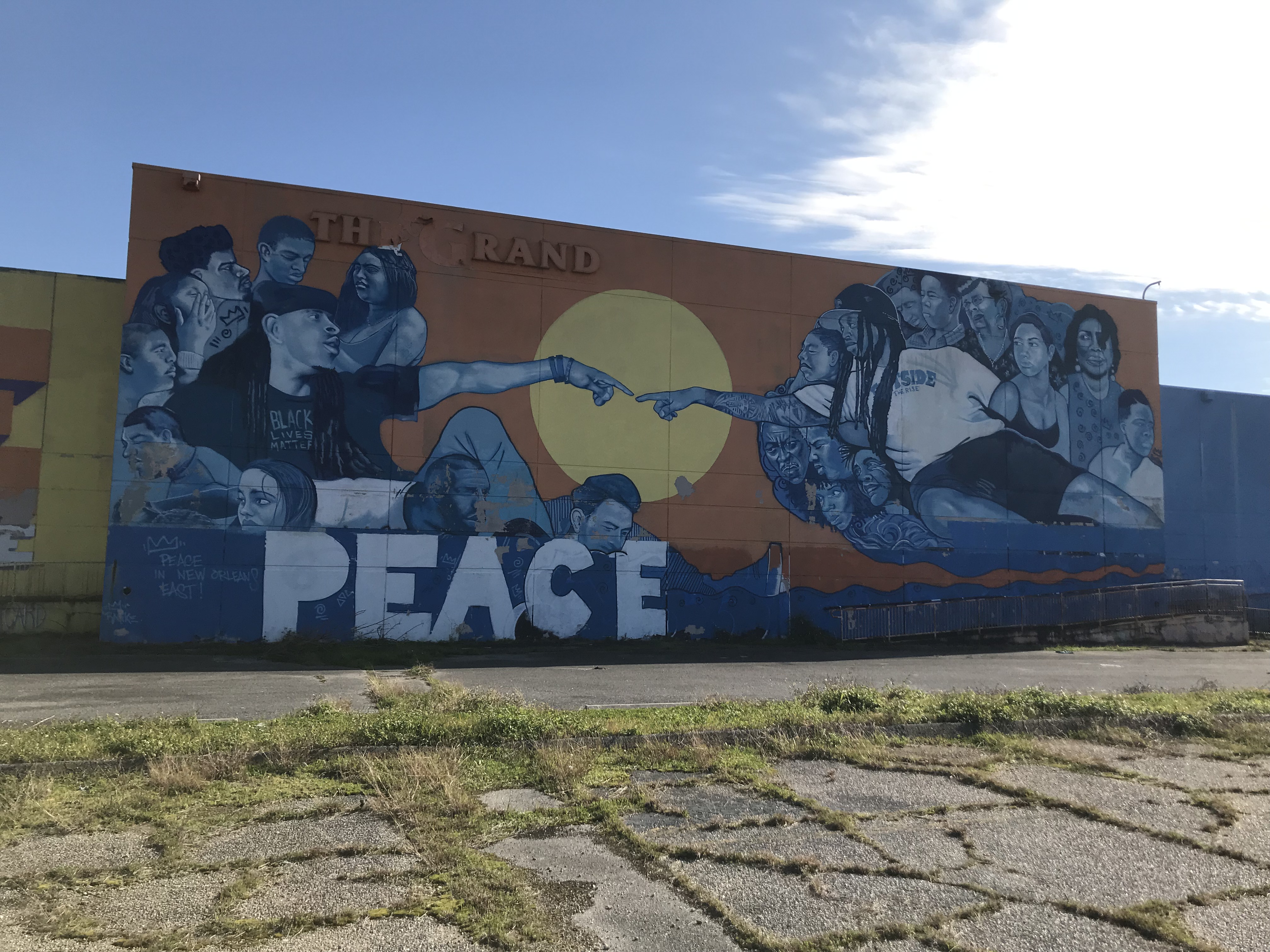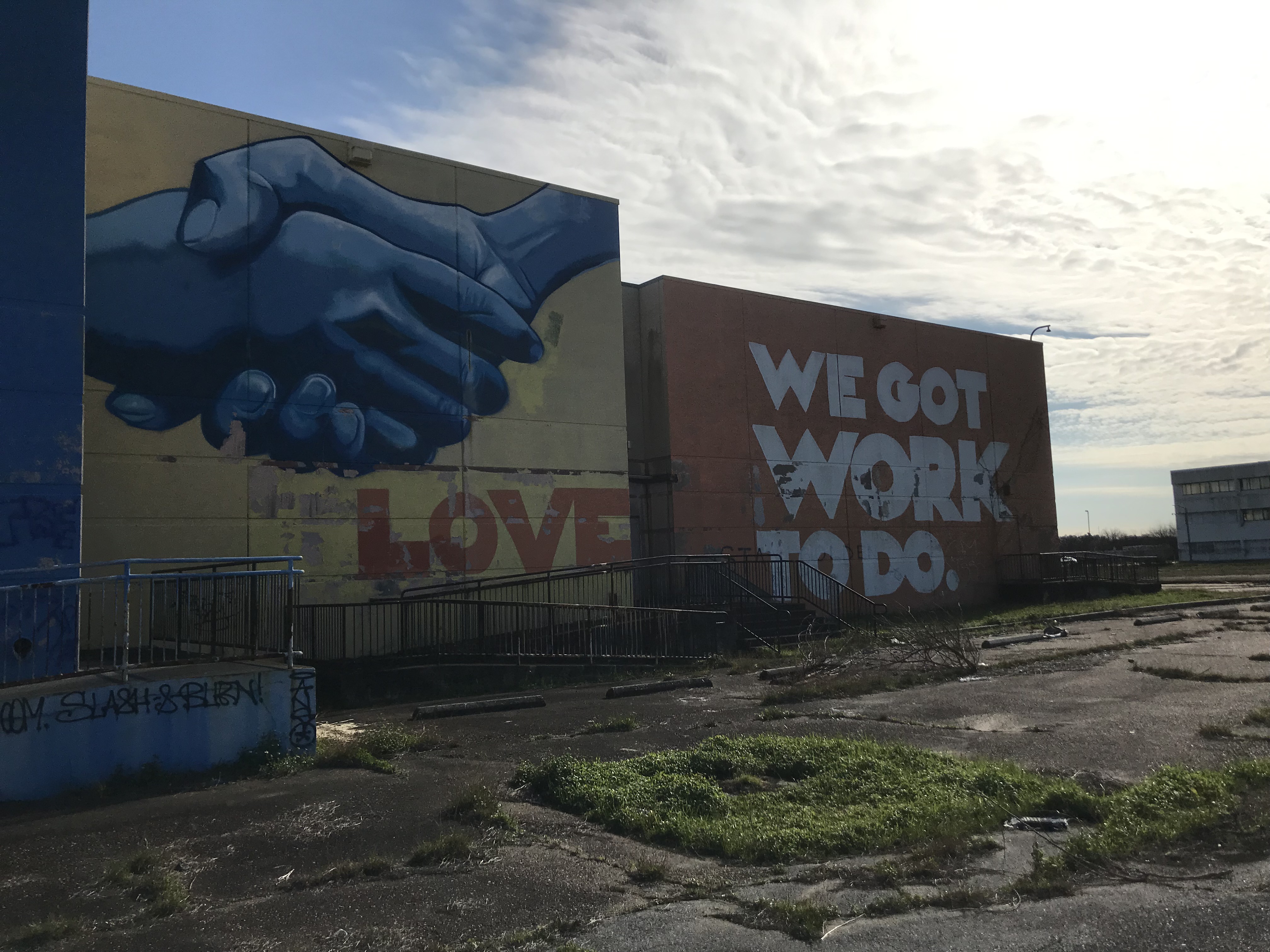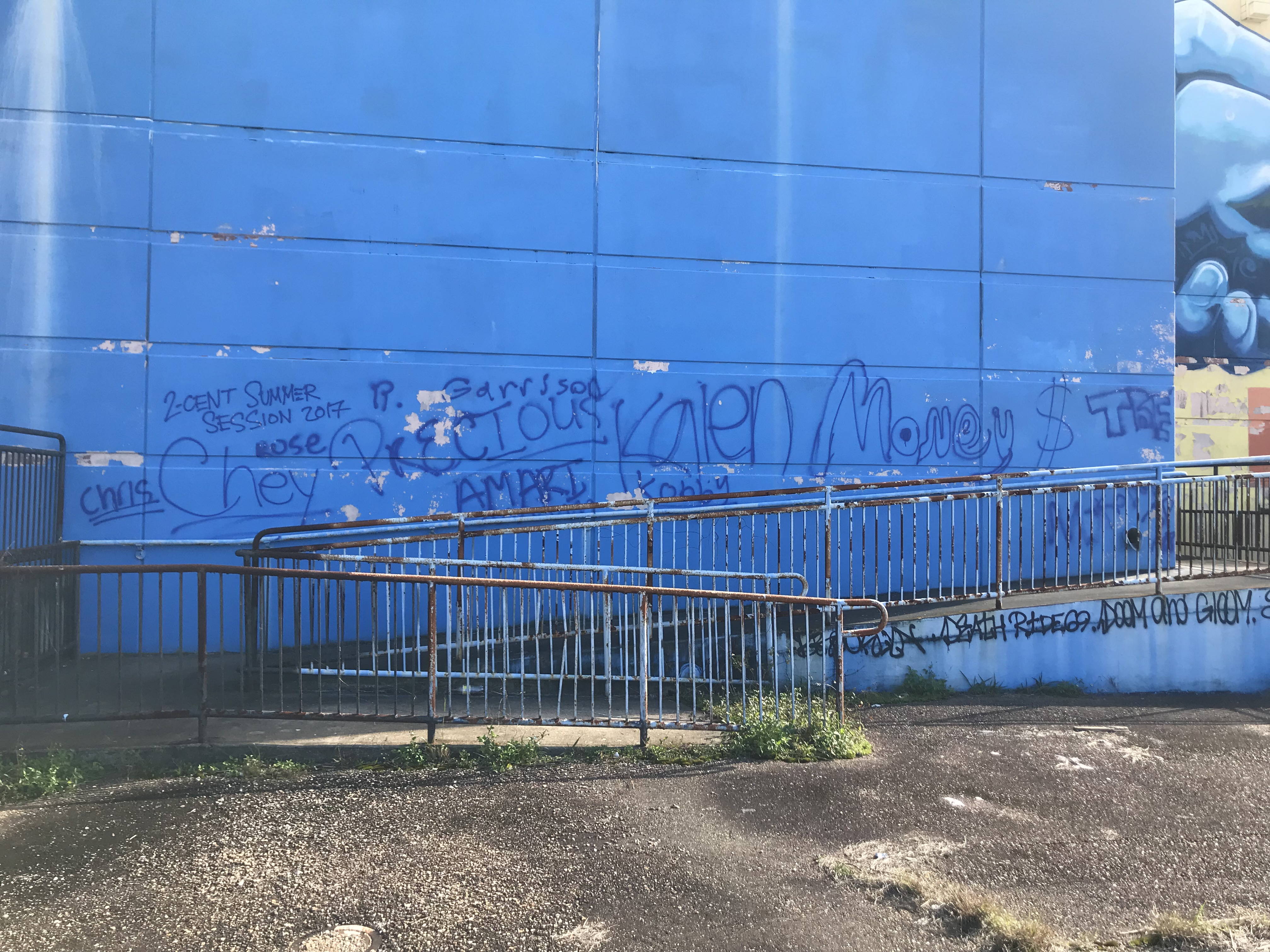
The Wall of Peace in New Orleans Ease (Photo by: Jacob Wasserman)
Since the beginning of the new year, eastern New Orleans has seen three shootings, the most recent one being on the 6500 block of I-10 Service Road. If you were to walk a mile east down the road of the crime scene, on your right hand side would be The Wall of Peace a mural created by artist Brandan Odums in the summer of 2015. In light of the ten-year anniversary of Hurricane Katrina, and the flood that substantially damaged the area, the mural urges community members to remain harmonious and peaceful. Yet, that can be a tall order in eastern New Orleans, which contains some of the most dangerous neighborhoods in Louisiana.
In the post-Katrina era, crime has steadily risen and continues to remain an issue. But Odom’s fruitful message remains loud and clear, standing 40 feet tall and laying 100 yards wide across the abandoned Grand Theater. Glistening shades of blue, yellow and orange shine on the I-10 West Highway, inviting drivers and spectators to engage with the piece. The phrases “we got work to do” and “be the change” stand boldly in large, block letters, while words like “peace” and “love” are integrated with the characters in the display. In return, rush-hour traffic turns into a moment of thoughtful consideration about the community.

Photo by Jacob Wasserman
The image seems to be loosely based off Michelangelo’s famous Creation of Adam from the ceiling of the Sistine Chapel.[1] However, instead of biblical figures the mural incorporates members of the New Orleans East community. The focal point displays two Black men touching fingertips over a bright yellow sun and gazing orange sky. While the writing on their t-shirts are partially covered by dreadlocks, one shirt writes “Black Lives Matter,” and the other looks to say “Eastside the Rise.” According to Odums, the arrangement, “features a lot of everyday people from the east, people who work in violence prevention, people who have lost loved ones, and, you know, just everyday people from this community.”[1] There is clearly an emphasis on creating a promising future, and the idea becomes conceivable by including ordinary people in the piece.
In order to understand the overarching theme of peace and prosperity, it is important to take a deeper look at the people who live in this community. While interning for a local news station in the spring of 2017, I visited neighborhoods in New Orleans East — just days after the city had been struck by the strongest tornado in its history. The scene felt surreal like a movie; the National Guard patrolled the borders of the area, debris filled the streets and roofs were ripped off houses. On a street surrounded by destruction, one house remained intact. Eight children danced on the front lawn, smiling and singing “Candy Girl” despite being without electricity for three days. Their reaction seemed bizarre given the circumstances, but when tragedy is not a scarcity, optimism is the only appropriate response.
The Wall of Peace’s current form mirrors the existing conditions of New Orleans. From a distance, the mural looks to have a vibrant, smooth flow, but upon closer speculation, chipped paint and graffiti tarnish many of the original images. While these details may not be noticeable to the public eye, neither are the social issues that remain prevalent in eastern New Orleans. As the mural sits in a secluded, dimly lit area, some may perceive it to be a gateway for vandalism rather than a work of art.

The Wall of Peace (Photo by Jacob Wasserman)
However, in order to properly communicate an idea it must be effectively distributed. This notion dates back to the 15th century, when Johannes Gutenberg’s printing press authorized the mass production of thousands of books into different languages.[2] In return, the printing press allowed for an expansion of idea and thought, leading to the Protestant Reformation that gave public access to the Bible which was formerly censored by the Catholic Church.
This mural, and public art in general, can also be used as a compelling way to express a collective belief. Murals present an excellent way of expressing underlying social and political issues, and have shown to be effective in communities across the country. In 1986, New York artist Keith Haring tagged a large handball court as a response to the prevalent crack epidemic. “Crack is Whack” still stands in Harlem to remind locals that despite facing hardships, a broken community can evolve into a prosperous one. Mural art programs have also been used as an initiative for civic engagement, such Urban ArtWorks in Seattle. The program is comprised of at-risk community youth who use mural art as a medium for building confidence and self-esteem.
It is essential that progressive art forms, such as mural art, should continue empowering children and adolescents moving forward. In her article “The Power of Urban Canvas: Paint, Politics and Mural Art Policy,” professor Maura Greanry explores the potential benefits mural art has on community youth: “By improving the physical as well as the social and psychological aspects of communities, mural art programs attempt to reach children who otherwise might be untouchable — those who, if left “un-reached,” would be unmarketable in this knowledge-based society.”[3] Reinforcing communal values through art is a prime way of building hope for the future, especially if it is inspired by youth involvement.
While murals such as The Wall of Peace appropriately signify the ideals of a community, change is only possible when people begin to take action. Creating a participatory culture will be vital to the reformation of eastern New Orleans, and although the mural was first displayed 14 years ago, the theme of togetherness holds true now more than ever.
Work Cited
 NOLAbeings Multimedia artist Claire Bangser created NOLAbeings as a portrait-based story project that marries...
NOLAbeings Multimedia artist Claire Bangser created NOLAbeings as a portrait-based story project that marries...  Voodoo in New Orleans: Reviving history: New Orleans fortune telling This article takes a deep dive into the history of Voodoo in New Orleans, its hybridization with Catholicism, and its present-day place in the city's culture. The author visits fortune-tellers in the French Quarter, using their guidance as a tool for introspection rather than a deterministic predictor of the future. Through her experiences in New Orleans, the author feels a mystical connection to both the past and the future.
Voodoo in New Orleans: Reviving history: New Orleans fortune telling This article takes a deep dive into the history of Voodoo in New Orleans, its hybridization with Catholicism, and its present-day place in the city's culture. The author visits fortune-tellers in the French Quarter, using their guidance as a tool for introspection rather than a deterministic predictor of the future. Through her experiences in New Orleans, the author feels a mystical connection to both the past and the future. 